Staffordshire Oatcakes Recipe
Staffordshire Oatcakes are a regional speciality of The Potteries and north Staffordshire. Unlike the biscuity Scottish oatcake, these are soft, oatmeal pancakes that are lightly risen thanks to the inclusion of yeast. Most often eaten alongside or filled with traditional breakfast foods like sausage, bacon, mushrooms, or tomatoes, plus cheese, they make a hearty breakfast, brunch, or lunch.
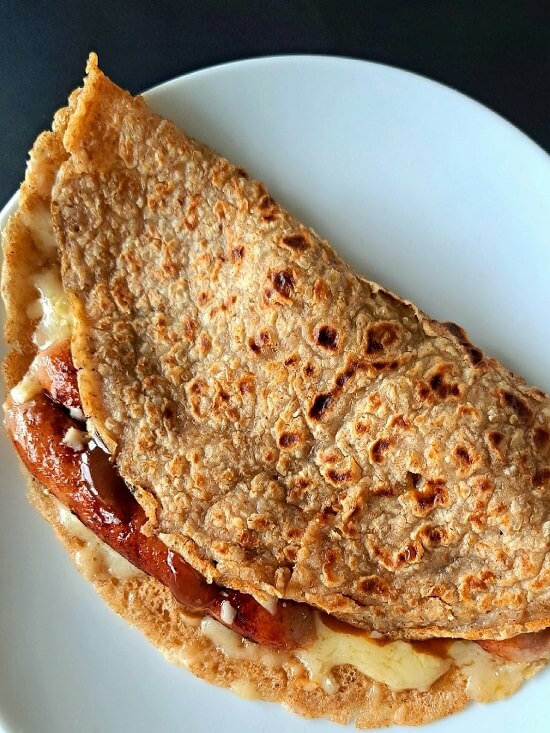
Needing just a handful of simple ingredients (oatmeal or porridge oats, flour, yeast, salt, water and/or milk), full-flavoured Staffordshire Oatcakes are cheap and easy to make at home.
In this post, besides my own recipe, you’ll find some background and history to the versatile oatcake.
Jump to Recipe
Disclosure: this post may contain affiliate links. If you buy via my links, I may earn a small commission at no extra cost to you.
WHAT ARE STAFFORDSHIRE OATCAKES?
If you don’t have a connection to the English county of Staffordshire, you probably haven’t heard of Staffordshire Oatcakes. You could even be forgiven for assuming they’re a version of crunchy Scottish Oatcakes. But you’d be wrong. Staffordshire Oatcakes are soft, yeasted oatmeal pancakes and a regional speciality.
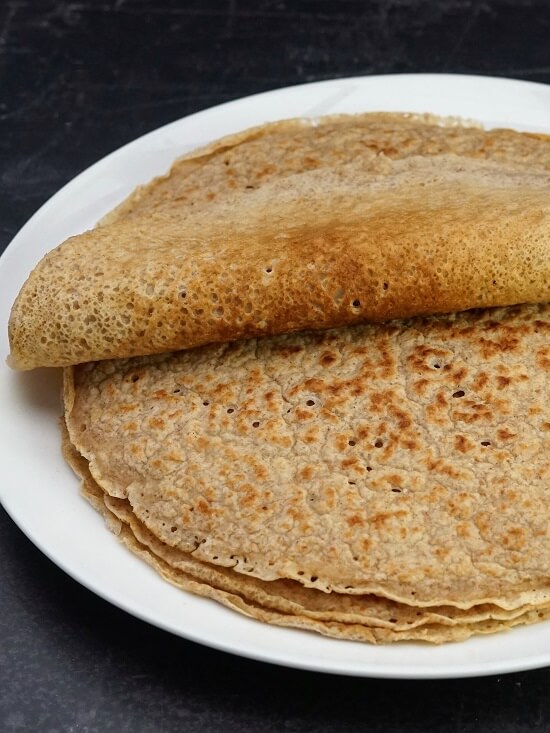
They’re usually eaten hot for breakfast, brunch or lunch with traditional British breakfast foods like sausages, bacon, mushrooms, tomatoes, and often cheese. They might accompany a full English breakfast instead of, or sometimes as well as, toast. They’re also eaten filled with some of the above goodies, maybe with ketchup or brown sauce, then rolled or folded.

Cheap, tasty and filling, I think Staffordshire Oatcakes deserve to be much more widely known.
HISTORY OF THE STAFFORDSHIRE OATCAKE
Although particularly associated with the six towns that make up the Staffordshire Potteries (which became the centre of world ceramics production in the Industrial Revolution), the history of the Staffordshire oatcake most likely goes back much further than that.
LEAVENED PANCAKES & GRIDDLE CAKES
In Elizabeth David’s epic English Bread and Yeast Cookery (Penguin, 1979), they’re listed as one of the ‘leavened pancakes and all the tribe of griddle cakes’ that allow the use of flours such as barley, buckwheat and oatmeal which aren’t wholly suitable for regular loaves of bread. Also, as humble cottages wouldn’t have had an oven, the only homemade bread would have been those baked on a griddle, hearthstone or bakestone. These, she says, included pancakes, pikelets, barley cakes and oatcakes.
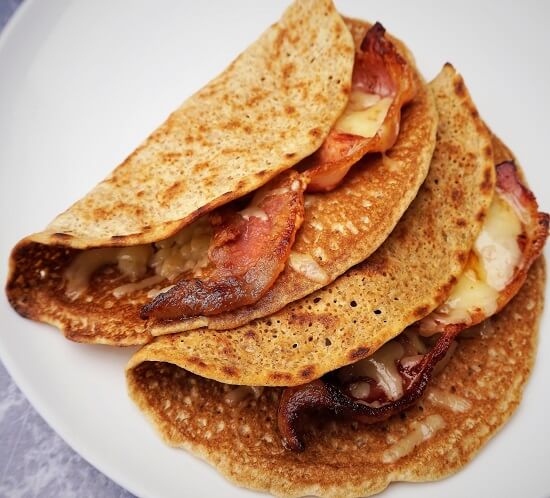
OATS
Given all that, plus the fact that wetter, more northerly areas of Britain are more suited to growing oats rather than wheat, it’s not surprising that there exist versions of oatcakes other than Scottish and Staffordshire. Elizabeth David cites Welsh Oatmeal Pancakes, Lancashire Oatcakes and Yorkshire Riddle Bread. Most like the Staffordshire variety, although not included in David’s book, are Derbyshire oatcakes. However, these tend to be larger, heavier and thicker.
Although almost thought of as a super-food today, oats were previously regarded as inferior to wheat. Even, perhaps, fit only for animal feed. In his 1776 biography of Samuel Johnson, James Boswell comments, on discovering oatcakes served at breakfast in Johnson’s hometown of Lichfield, ‘It was pleasant to me to find that oats, the food of horses, were so much used as the food of the people’.
THE INDUSTRIAL REVOLUTION & BEYOND
In the industrial age, the Staffordshire oatcake became a staple for workers in the Stoke-on-Trent potteries. According to local historian Fred Hughes, farm labourers brought the tradition with them when they came to work in the factories. Cheap and portable, oatcakes became so commonplace that every terraced street had an oatcake shop alongside the grocer, pub, and fish and chip shop. Often these were hole-in-the-wall affairs: ordinary houses selling homemade oatcakes through the window.
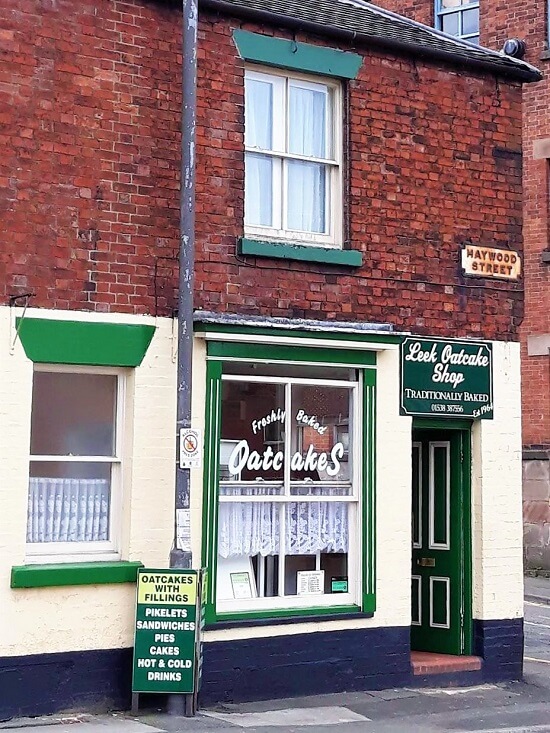
There are still around 20 – 30 oatcake shops in Stoke-on-Trent, plus some in other parts of north Staffordshire such as Leek. Some make oatcakes in the traditional way, hand mixing and hand pouring onto a baxton (from the words bakestone/backstone). Others are mass produced, machine poured, and cooled by fans. You can buy a batch to take home, heat and eat, or buy them ready filled to eat on the go. You’ll also find oatcakes on breakfast, brunch, and lunch menus all over North Staffordshire.

My own village is home to a mobile oatcake van that appears at markets and food events. You might even spot oatcakes from a couple of the big producers in the odd local supermarket.
SPREADING THE WORD
So, it seems that Staffordshire Oatcakes are thriving on their home turf. But I don’t think they’re very well-known elsewhere, despite the annual Oatcake Day sometimes trending on social media. I’d like to think that last year’s episode of BBC Radio 4’s The Food Programme, all about oatcakes in Stoke-on-Trent, spoke to a new audience. And perhaps the recent development of oatcake mixes, shipped to ex-Stokies far from their nearest oatcake shop, will help spread the word elsewhere.
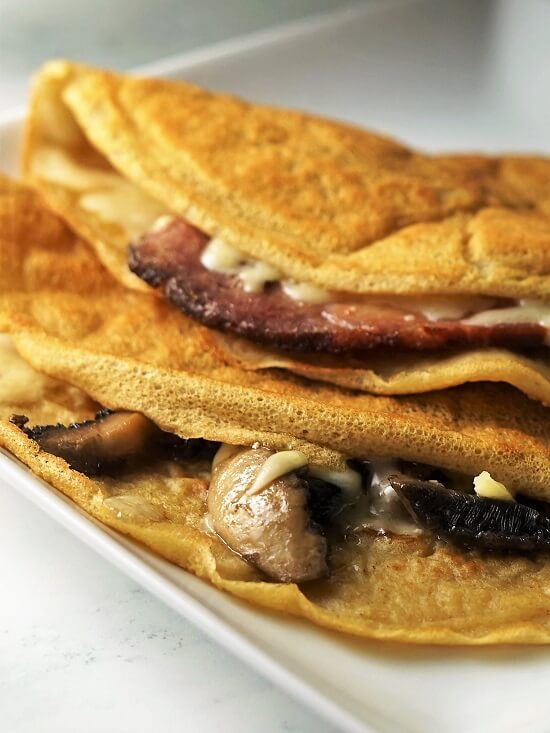
But I think there’s yet another way to get Staffordshire Oatcakes in more homes. By making them from scratch, and very cheaply, in our own kitchens.
MY STAFFORDSHIRE OATCAKES
Just as every oatcake shop is said to have its own (secret) recipe, what follows is my way of making of oatcakes. I don’t claim they’re more authentic than any others, they’re just how I like them after tinkering with the recipe over the years. If you’re making Staffordshire Oatcakes for the first time, use my recipe as a starting point but feel free to adapt it to your own tastes.
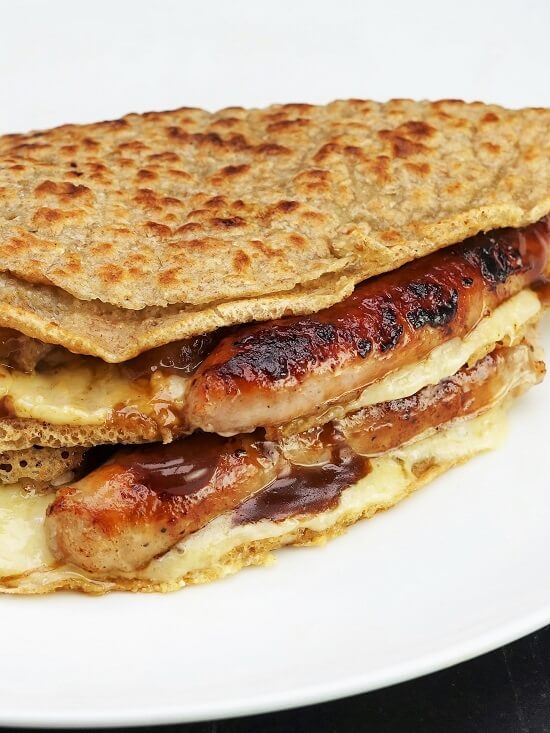
Jump to Recipe or continue reading
INGREDIENTS FOR STAFFORDSHIRE OATCAKES
As you’d expect from a food associated with working people, the ingredients to make Staffordshire Oatcakes need not be expensive.
OATMEAL
In the UK, oatmeal is made from ground oats. For readers in the USA, what you call oatmeal is our porridge. Oatmeal is sold as either fine, medium or coarse, and you’re more likely to find it in a health food shop than a supermarket. You might see packages labelled ‘oat flour’, but these can expensive. I saw some at £4 for 450 grams. Compare that to a local independent shop where I buy 500 grams of oatmeal for just 80p.
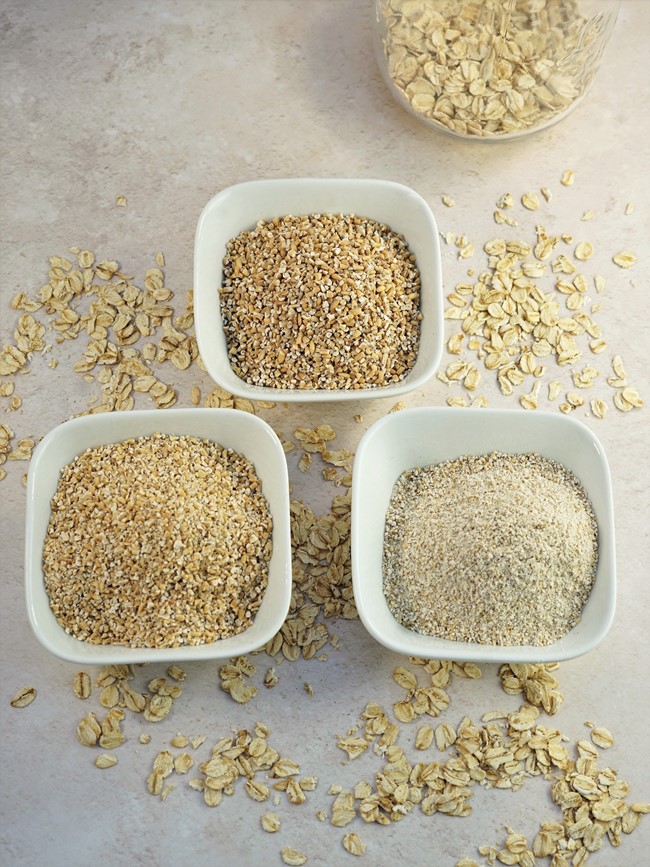
If you can’t find oatmeal, you can easily make your own anyway. Simply whizz rolled oats or porridge oats in a blender or food processor. Fine or medium ground is best for Staffordshire Oatcakes. By the way, if you see oat bran for sale that’s not the same thing at all and isn’t suitable for oatcakes.
FLOUR
Oatcakes in Staffordshire and elsewhere may originally have contained oatmeal as the only flour. But these days Staffordshire Oatcakes pretty much always contain a proportion of wheat flour. That’s because oats contain virtually no gluten, so combining them with gluten-containing flours makes them both lighter and, I suspect, less likely to tear.
I find that half oatmeal and half wheat flour gives a good texture while still being satisfyingly oaty. But you can experiment with more oatmeal and less flour to see what suits you. It’s also up to you whether you use all wholemeal, all white, or a combination. My preference is for mainly wholemeal with a little white for lightness.
Another choice is whether to use plain flour or bread flour. Using bread flour gives strength to the oatcakes, making them less likely to break when turning or folding. Personally, I prefer the slightly chewier texture too. But ordinary plain flour can be substituted if liked.
YEAST
Traditional oatcakes would have been made with fresh yeast or, further back, perhaps some version of a sourdough starter. But dry yeast is more readily available, convenient, and has a relatively long shelf-life. I always use ones labelled ‘fast acting’, ‘instant’ or similar. This means it doesn’t have to be activated before adding to the dry ingredients. This is the type you need for my recipe.
BICARBONATE OF SODA: YES, OR NO?
Many ready-made oatcakes, and the oatcake mixes that have recently come on the market, often contain the raising agent bicarbonate of soda. But I find it unnecessary with yeast risen homemade Staffordshire Oatcakes. More than that, I think bicarb can give an unpleasant tang. So, I stick to using it for things like Soda Bread. But if you want to include some in yours to make the batter bubblier, then it’s usual to add a teaspoonful after the batter has proved.
WATER AND/OR MILK?
As a cheap foodstuff, the only liquid in traditional oatcakes would surely have been water. But a mix of half milk and half water is now common for homemade versions as it gives better flavour. If you prefer water only, I recommend adding a teaspoon of sugar to the flour. This will help feed the yeast in the absence of the lactose (a type of sugar) found in milk.
SALT & FAT FOR COOKING
The only other ingredients you’ll need are salt for flavour and some fat for cooking the oatcakes. For the initial cooking I use sunflower oil as it has a neutral flavour. I make a whole batch of oatcakes in one go, then reheat as needed, sometimes using other fats depending on what I’m eating them with. I’ll talk more about that further on.
MAKING THE BATTER: WARM OR COLD?
To make the Staffordshire Oatcake batter, we put the oatmeal, the flours, the dry yeast, and salt into a bowl. Then the combined milk and water is stirred in to create a thinnish batter. The desired consistency is often compared to that of single cream. Once it’s sat for a while it will thicken as the oatmeal is absorbed. But don’t worry too much at this stage, a little more liquid can be added later.
The ideal temperature for yeast to ferment is said to be 38 degrees centigrade. So, in theory, that’s the temperature the liquid should be. But there’s actually a huge range of temperatures that will get yeast working.
If you’ve seen any of my overnight bread recipes, you’ll know that I make doughs with water straight from the tap and/or milk from the fridge. The yeast will work at these temperatures, but it will take considerably longer to get going. On the plus side, longer fermentation should give better flavour. So, if you want to make the batter the night before, then just add the liquids cold, cover, and leave overnight.
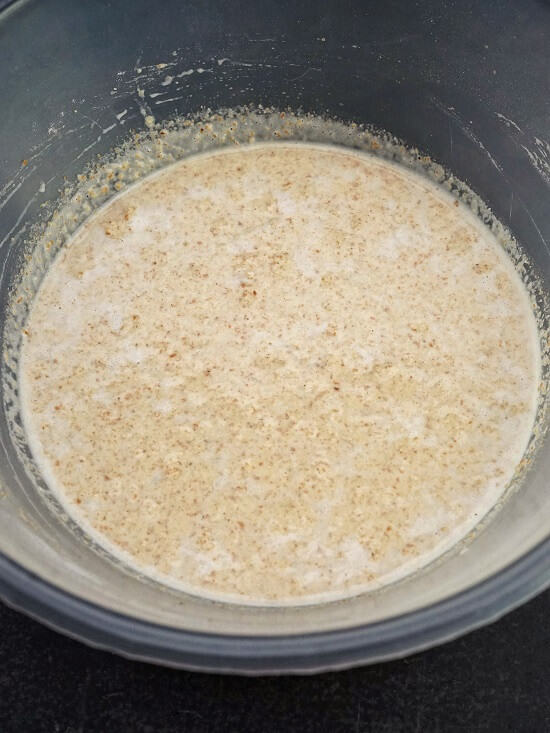
THERMOMETER OR FINGER?
However, if you want to cook the oatcakes the same day, you’ll need to heat the milk and water. As I have a food thermometer, I just pop the liquid in the microwave and gradually heat it, taking its temperature every few seconds or so. If you don’t have a thermometer, then you can judge by putting your finger in the liquid. As 38 degrees is just above normal body temperature, it should feel pleasantly warm rather than hot. If in doubt, err on the side of cooler: if the liquid is too hot then it will kill the yeast.
Unless you’re using the overnight method, the batter should ideally be left somewhere warm. I put it in my small top oven which I’ve previously heated for a few minutes then switched off. Depending on the temperature (not too hot, remember), the batter will take 15 – 30 minutes to start looking bubbly and foamy. That means it’s ready. Those of you who want to include bicarbonate of soda whisk it in now.
COOKING STAFFORDSHIRE OATCAKES
If you’ve cooked Traditional English Pancakes, then you’ll have no problem with Staffordshire Oatcakes.
THE FRYING PAN & THE HEAT
For most home cooks, it’s easiest to use a shallowish, non-stick frying pan or crepe pan rather than a griddle. I do have an electric griddle but prefer the nice round shape I can get with a pan. It’s one I bought many years ago for making Indian dosa and it’s perfect.
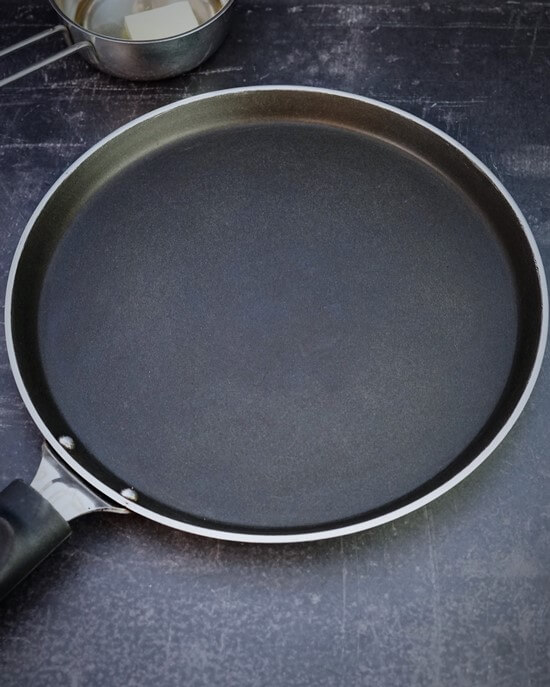
The Staffordshire version of oatcakes are usually between 15 – 18 centimetres (6 – 7 inches) in diameter so this is the size pan you’ll need. Everyone will have their own idea of how thick or thin an oatcake should be. I lean a little to the thinner side so find 100 ml of batter just right for my 18-19 cm pan. For this batch, after adding an extra splash of water to get it back to single cream consistency, I conveniently had 800 ml of batter. Perfect for making 8 oatcakes.
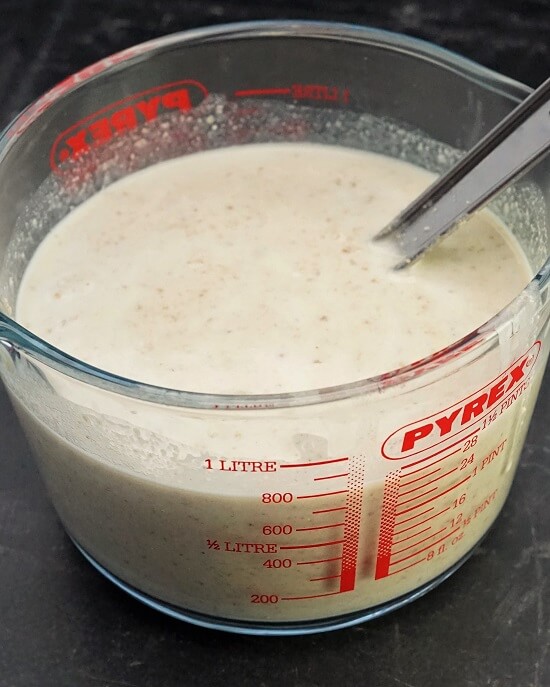
I cook them over medium-high heat. My electric hob goes up to 6 and I have it at 4. If you’re making thicker oatcakes, they might take a little longer so turn the heat down a smidgen if they darken too quickly. You need very little oil in the pan: when it’s hot I brush some over then pour off the excess.
FRYING THE OATCAKES
Before pouring in your first lot of batter (I transfer it to a jug to make this easier), give it a quick whisk to reincorporate any solids that have sunk to the bottom. Then, as you pour the batter into the hot pan, lift and tilt so it runs and flows to completely cover the base. If your pan is hot enough, you should immediately see bubbles forming and popping. Leave the pan on the heat until the underneath is warmly golden brown: use a spatula to peek. The upper side should look dry with no liquid batter. This should take 1 ½ – 2 minutes but don’t attempt to turn too soon or the oatcake may break.

When the first side’s done, use a spatula to turn over the oatcake. Alternatively, if you’re completely reckless, you can flip it. Cook the other side for a similar length of time: it should be set and covered in darker brown patches. Transfer the finished oatcake to a cooling rack or a plate, then re-oil the pan and continue making oatcakes until all the batter is used up. Stack the cooked oatcakes on top of each other, and don’t forget to give the batter a good stir before pouring each time.

And that’s all there is to it. With a bit of practice, you’ll be making the oatcakes quickly and easily. Don’t worry if your first one is far from perfect though. That’s often the way. Just keep going and you’ll find the heat, timing and rhythm that works for you.
STORING & REHEATING STAFFORDSHIRE OATCAKES
Kept in a polythene bag, on a plate covered in cling film, or in an airtight container, oatcakes will keep fresh for two or three days. I store mine in the fridge or, if they’re not all going to be eaten within two days, I freeze them. You could stack them with greaseproof paper or clingfilm in between so you can take out just as many as you need and defrost. But I roll up each one and freeze them spaced apart on a clingfilm-lined tray. When frozen I transfer them to a freezer bag. Great for impromptu meals, I usually defrost in the microwave.
Because oatcakes reheat so well, even if I’m eating them soon after cooking, I don’t bother to keep them warm. The quickest way to reheat, if you don’t mind hot and floppy, is in the microwave. But a frying pan, under the grill, or on a griddle is much nicer. I most often go for the pan or, so I can prepare two at a time, this brilliant electric table top grill (paid link).
If I’m having the traditional sausage or bacon with them, I reheat the oatcakes in a smear of the meat’s cooking fat. I wipe out the pan, leaving just a little of the fat behind. Then I put in the oatcake and cook until the underside is hot and slightly crispy, turn over and repeat. When there’s no meat fat, such as for a simple cheesy oatcake, I’ll reheat in a little butter.

Apart from a plain oatcake for dipping with a full English breakfast, my favourite is a filling of cheese, sausage, and brown sauce. I reheat the first side as above, turn, and sprinkle with grated cheese. Once that’s starting to melt nicely, I put on the hot sausages plus a squirt of brown sauce. While a rolled oatcake is good for transporting or eating on the go, at home I prefer to just fold them. I reckon you can also get more filling in a folded oatcake!
A TRADITION REVIVED
For a while, it looked like the Staffordshire oatcake was dying out. But with more people developing an interest in regional and traditional British foods, it’s future in its homeland seems secure. I think it would be great though if that love of oatcakes could be spread wider by home cooks learning how to whip up a stack.
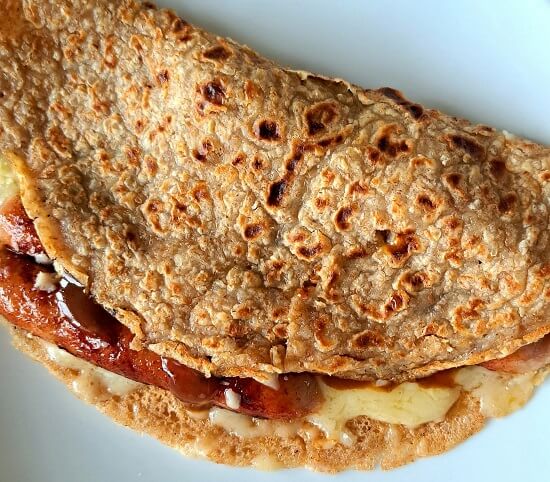
Cheap and easy to make with readily available ingredients, versatile (as with other pancakes, you can even eat them with sweet fillings) there’s no reason at all why the rest of the country can’t fall in love with Staffordshire Oatcakes too.
Have you made my Staffordshire Oatcakes? I’d love to know what you thought, especially if you’ve never eaten oatcakes before.
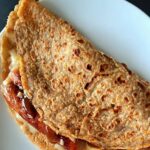
Staffordshire Oatcakes
These easy, economical yeasted oatmeal pancakes are a speciality of north Staffordshire and are usually served alongside or filled with traditional breakfast foods like sausage, bacon, mushrooms, tomatoes, plus cheese.
But, as with other pancakes, there's no reason you can't eat them with sweet fillings too.
Ingredients
- 125 g oatmeal, fine or medium see Recipe Note 1 including making your own
- 75 g wholemeal bread flour or plain wholemeal flour: see Recipe Note 2
- 50 g plain white flour can be replaced with more wholemeal flour
- 1 tsp instant dry yeast the type that doesn't need activating first
- 1 tsp salt
- 250 ml water
- 250 ml milk can be replaced with more water: see Recipe Note 3
- oil e.g. sunflower for greasing griddle or pan
Instructions
-
Put the oatmeal and flours into a mixing bowl along with the salt and yeast.
-
Method 1: Making the batter the same day as the oatcakes.
Combine the water and milk and heat to 38°C. If you don't have a thermometer then heat until it feels just warm when a finger is held in it: if in doubt, err on the side of cooler as hot liquid will kill the yeast.
Method 2: Overnight batter.
A longer, overnight fermentation should give better flavour. For this method there's no need to heat the liquids.
-
Stir the contents of the mixing bowl then gradually pour in the combined water and milk, whisking all the time to create a batter the consistency of single cream. Add a splash more water if necessary.
Method 1: Cover and place somewhere warm for 15 - 30 minutes or until the surface is foamy.
Method 2: Cover and leave at room temperature overnight.
-
Put a 15 - 18 cm pancake, crepe or shallow non-stick frying pan over medium-high heat.
When hot, brush over a thin layer of oil then pour or wipe off any excess.
Whisk the batter and, if necessary, add a little more water to bring it back to single cream consistency. For easier pouring, you can now transfer it to a jug. Otherwise, you'll need a ladle.
Pour or ladle approximately ⅛ of the batter into the pan: quickly lift and tilt the pan so the batter flows over and covers the base. If your pan is hot enough, you should immediately see bubbles forming and popping.
Cook until the underside is golden brown and the top is dry with no loose batter (approx. 1½ - 2 min). Turn and cook the other side until it's set and covered in darker brown patches.
Transfer the oatcake to a cooling rack or plate.
Re-oil the pan and continue making oatcakes until all the batter is used up. Remember to stir the batter before pouring each time. Stack each oatcake on top of the previous one.
-
Storing and reheating.
Oatcakes will keep at least 2 - 3 days covered and stored in the fridge. They can also be frozen: stack them with cling film or greaseproof paper between each one or roll, freeze on a lined tray then transfer to a freezer bag.
Oatcakes can be quickly reheated in a microwave but are better in a lightly greased pan or under the grill.
Serving suggestion: have ready some cooked bacon or sausages.. Leave a little of their cooking fat in the pan, put in an oatcake and reheat on both sides. Sprinkle with cheese, allow it to melt, then top with hot bacon or sausage plus a squirt of ketchup or brown sauce if liked. Roll or fold then transfer to a plate to serve.
Recipe Notes
Note 1 Oatmeal. Although in the US oatmeal refers to what we in the UK call porridge, over here oatmeal is a flour made from ground oats. You're more likely to find it in a health food shop rather than a supermarket, but you can easily make your own by whizzing up rolled oats or porridge oats in a blender or food processor.
Note 2 Type of flour. Using bread flour gives strength to the oatcakes, making them less likely to break when turning or folding. Personally, I prefer the texture too. But plain flour can be substituted if that's what you have. Some or all of the wholemeal flour can also be replaced with white flour.
Note 3 Water and/or milk. Traditionally, the only liquid in oatcakes would be water. But a mix of half milk and half water is now common for the homemade version as it gives better flavour. If you prefer water only, I recommend adding a teaspoon of sugar to the flour: this will help feed the yeast in the absence of the sugar (lactose) found in milk.
RELATED POSTS

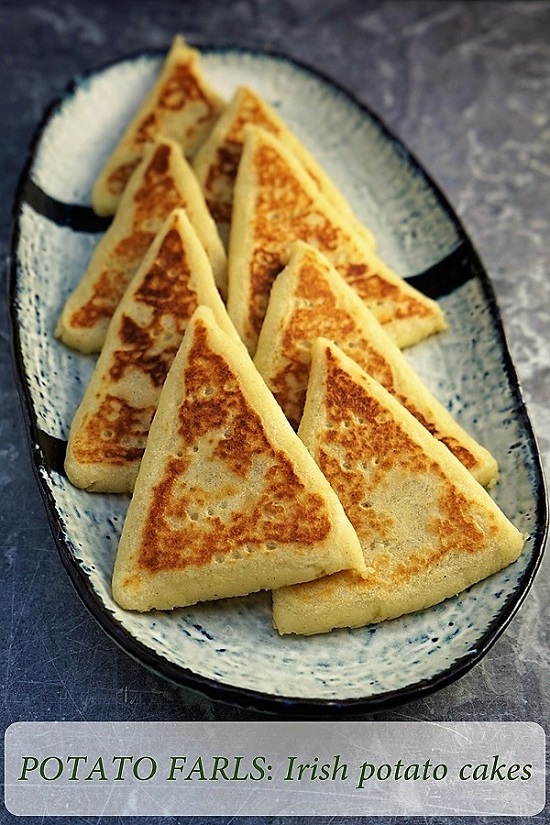
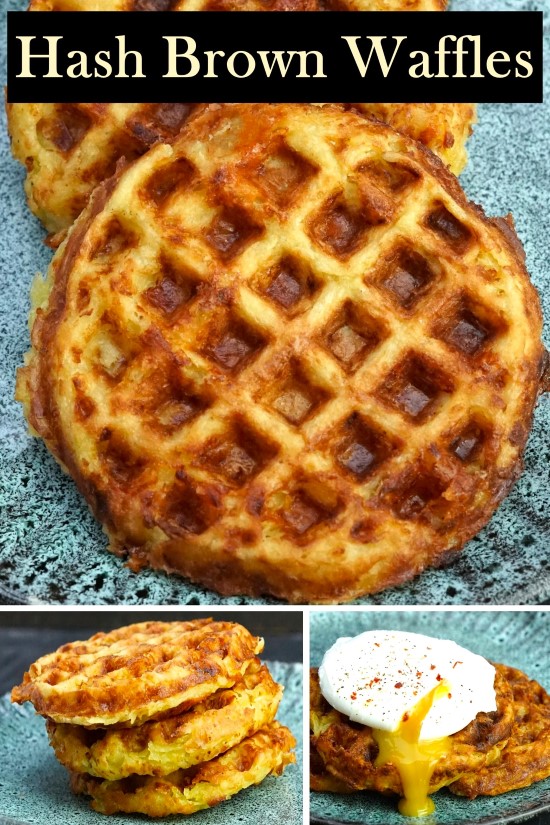
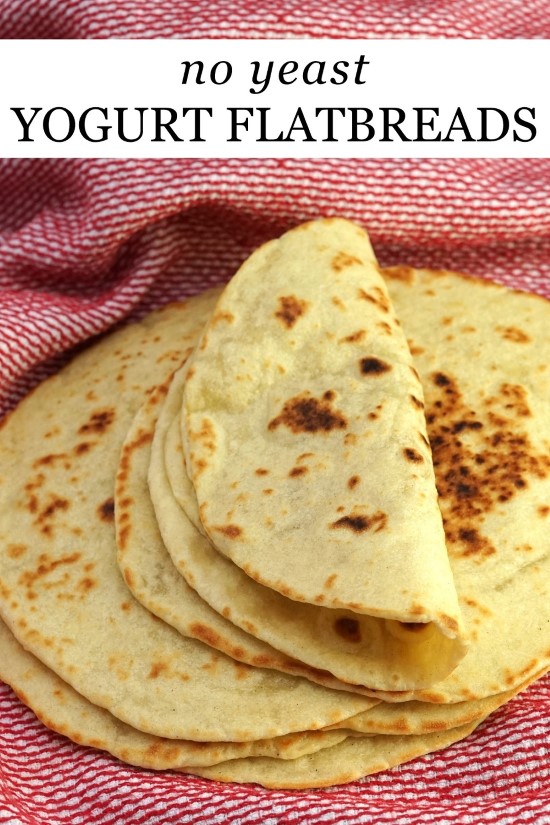

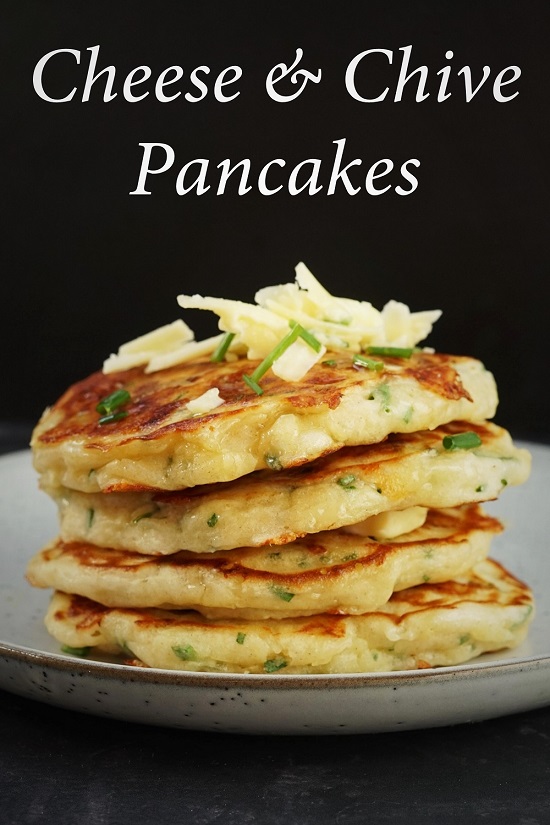
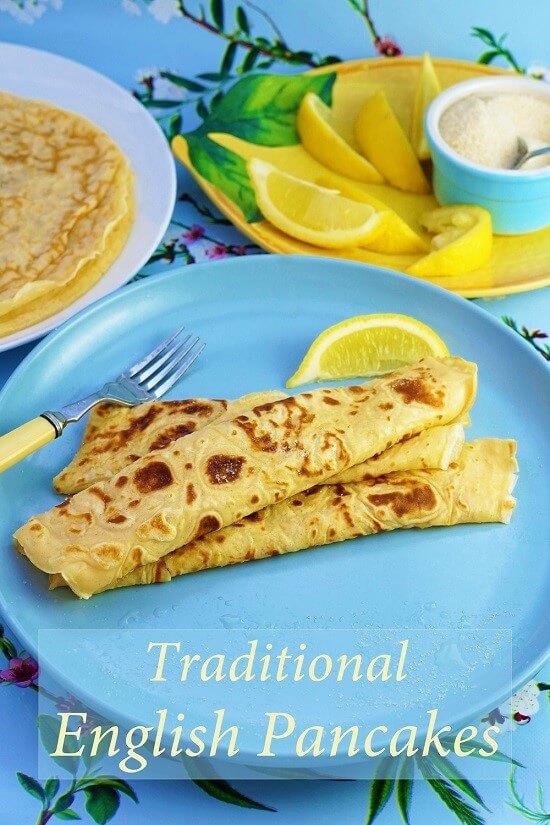
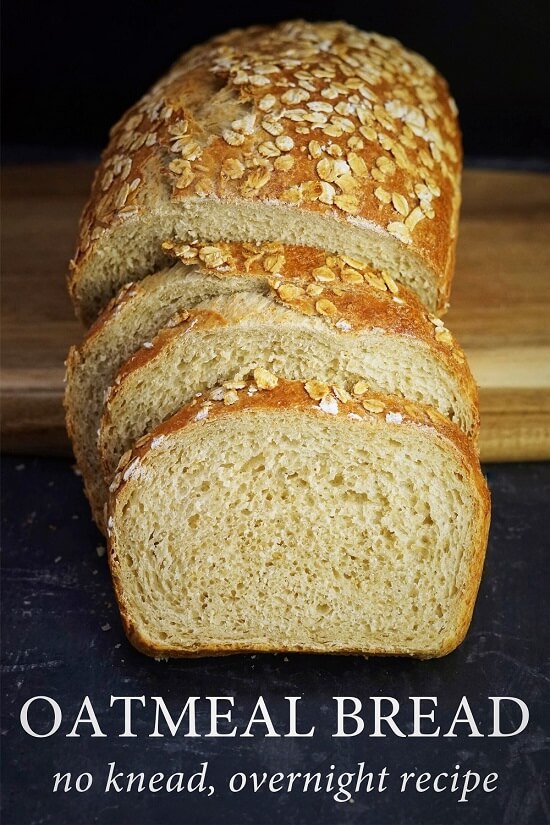


I’ve just made these, and they are amazing!! I’ve been living in Italy for nigh on 20 years now, and the oatcake is definitely one of my go-to foods when I’m back at home. I’m no cook, but these were really easy to make. Next time, I’ll be nuking an enormous batch to freeze rather than just the 8 we scoffed down straight away! Thank you so much for posting this recipe! 😊😊
That’s so great to read, Emma. Thank you!
Making!! Definately not nuking😁
😁
I was introduced to oatties 30 years ago while working in a large office at Telford Shropshire. There were some folks who commuted from Stoke and once a week would bring in some from an oatcake shop filled with sausage or bacon and grilled cheese on, individually wrapped in foil to keep warm. They were a revelation!
Since then I have bought the shop ones to fill at home but yesterday decided to make them for today’s breakfast and am so glad I did. With bacon, mushrooms, cheese and homemade HP sauce these are now the future 👌
So glad you enjoyed my Staffordshire oatcakes recipe, Andrew! And I love the sound of homemade brown sauce to go with them – although I must admit to being a Daddies sauce devotee rather than HP 😁.
I also heard the Mark Steele’s in town episode, well worth a listen, and found myself with cravings for Oat Cakes. They used to sell them in Sainsburies in Liverpool but they stopped stocking them. I was introduced to them by a friend years ago and I regularly used them for making Prawn and Corriander quesadillas, and I’ve never found a suitable replacement. So I’ll give this recipe a go, they look great.
Yes, I’ve gone back and listened to it now. It was a good episode. Hope you enjoy my recipe if you try it!
What a coincidence re Staffordshire Oatcakes, as yesterday (15/7/24) the BBC R4 programme ‘Mark Steele’s in Town’ came from Stoke-on-Trent and the local oatcakes were discussed vis a vis the Scottish version. As usual I was looking for something else and found your beer bread recipe (which I’m looking forward to trying this weekend) and then noticed your Staffordshire Oatcakes which I also want to try as they sound totally yummy.
I was going to listen to that programme too as it was about Stoke, but then forgot! I’ll maybe go to the iPlayer and check it out. Hope you like my oatcakes if you make them!
These are fantastic, really tasty. Thanks very much!
Thank you, Julie!
Thanks these look splendid I shall bake them tomorrow using a natural leaven.
Just one comment. Are you sure you mean 38C for the fermentation temperature?
Bread yeast C. Milleri is at peak fermentation at 30C. It then rapidly falls of above that and has completely stopped fermenting at 36C.
28C is the ideal temperature for maximum fermentation action.
Though as you indicate slower fermentation gives better flavour and 24C is a nice balance.
This was a great read and so well produced too.
Thank you.
Hi Kevin, many thanks for your interest in my recipe for Staffordshire Oatcakes and your kind comments about the blog post!
I suggest that 38C is the ideal temperature of the liquid you add to the rest of the ingredients. Therefore the batter itself will be LESS than 38C and much nearer to the figures you suggest.
I remember purchasing oatcakes at the end of WWII on a Saturday evening when visiting my Grandparents in Birches Head. They were cooked on a large flat griddle heated with lots of small gas flames. I left North Staffordshire in 1962 but have continued to cook oatcakes, particularly for Sunday breakfast with a recipe similar to yours. My Grandfather died of Pneumoconiosis, caused by siliceous clay dust. The grey features of potters and miners suffering from this disease was common in my childhood caused in part by the nature of the shale dust in the local mines. The popularity of the oatcakes was mainly due to it being a a soft, cheap food that salved the workers dry, dusty, irritable larynx. In this modern world it is a delightful food with a long Industrial history. Sir Roy Griffiths was a pupil at Wolstanton County Grammar School, Director and Deputy Chairman of Sainsbury’s and was engaged by Margaret Thatcher in 1983 to produce a report on the management of the National Health Service. Whilst he was employed by Sainsbury’s and for a short time afterwards, Staffordshire oatcakes were on the shelves of all Sainsbury’s stores.
Many thanks for your comment, Stuart. Lots of interesting history in there that was new to me!
Had my first ever Staffordshire Oatcake today after living in Leek for 18 months and talked about making my own. Weirdly, up popped your post about Socca, which I really enjoyed and continued to scroll until Oatcakes history and recipe discovered. Thank you for sharing.
As a lover of food and cooking, I’ll keep following your posts as they’re beautifully written and very engaging to read.
You mention that you’re home village is Cheddleton and I did wonder if you had a cookbook out or just wrote blogs?
Your writing interests me as I’m the organiser of the new Leek Loves Books Festival and I put on monthly talks with authors and just wanted to reach out to see if you’d be interested in doing a talk/in conversation-style event about blogging and food writing, possibly with a bit of tasting?
We haven’t had someone chatting about this genre and I thought it might capture other food loving readers’ interest.
(I’m planning on organising a food festival here in the Future-Leek Loves Cooks, although it’s in the idea stage at the moment, I’d love to get another event off the ground-interedted)?
Hi Sam, thanks for getting in touch and also for your kind words about my posts! I occasionally think about writing a cookbook but it’s not something I’m planning in the near future, so it’s blog recipes only for now, plus I’m dipping a toe into Substack. I am aware of the Leek Loves Books Festival and I’ll contact you by email if that’s ok?
Thanks again for reaching out!
Regards, Lynne (Moorlands Eater).
When I was a kid, we had a caravan holiday in Derbyshire, and bought oatcakes from a market there, we’d never seen them before . My mum always brought a couple of tins of M&S chicken in white sauce along, and we had the oatcakes layered in a stack with that, it was one of the best meals I’ve ever eaten! I tried many times to recreate them, but pre-internet there was no way to find out about them, and I never succeeded – I didn’t know they were made with yeast, for a start. Now I live in France, but a couple of years ago I went to a mostly Brit garden party gathering, there was a bring and buy cake stall and a chap from Derbyshire brought along a pile of them, which I snapped up. Now I fancy making them myself, so I shall try this recipe – I know these are the Staffordshire variety, but I think in fact the original ones I remembered were rather more like this, quite large and thin.
Lovely site, you can’t beat British baking!
Thank you for your interesting and lovely comment, Lucy! Do come back and let me know if my version lives up to expectations if you try them, with or without the M&S chicken in white sauce 😁.
Came out great! Having no quick Yeast, I proved the yeast in the liquid (1/2 milk) first. Followed directions otherwise.
Glad to hear they came out great!
For the first time ever after numerous attempts, I have finally made decent oatcakes thanks to your recipe!
I found I had to have the pan at temperature 250C – does that sound right?
I actually used a Wheat/Oats flour mix from Matthews Cotswold Flour which has a few rolled oats in it. I was quite prepared for another failure due to not using your recommended flours but this worked well.
I can hold up my head up high in North Staffs now! Thank you
Hi John, so pleased my recipe has finally brought you oatcake success!
I’m not sure about the pan temperature: I have an electric hob and (I only learned this recently) the numbers don’t refer to a particular temperature but a rate of heat input and they do increase in heat in use. But as long as you found what works for you then great!
I guess using a particular flour blend rather than my suggested ratios of oats and wheat flour means your oatcakes won’t be the same but, again it’s all about what you like!
Thanks so much for your feedback!
Fabulous recipe. I live in Staffordshire and my family love oatcakes but this is the first time I’ve made them. Really simple, I made my own oat flour and did an overnight prove ready for breakfast. 😋
Thank you
Thank you for the great feedback! So pleased you enjoyed my oatcake recipe, and with your own homemade oat flour too!
These are lovely! And so easy to make. They will become a staple in my monthly menu planning 🙂
I first came to your site in search of a good recipe for Scottish oat cakes using what are called “Scottish oats” here in the US. That recipe led me to this recipe, and to various scone recipes. I make scones often and I enjoyed comparing notes.
I do have a small request. As a kitchen guy, I’m pretty good at metric conversion for measuring, but less so with temperatures for the oven. Also, it seems you typically measure many dry ingredients by weight, rather than volume.
Is it possible to include the temperatures in Fahrenheit and the dry measures in volume? It would certainly make these recipes a bit easier for the Yanks reading your blog. Thanks for these great recipes!
Hi Colin, many thanks for your interest in my recipes!
I deliberately don’t include volume measurements for non-liquid ingredients as there’s too much room for inaccuracy. So I always recommend using scales unless it’s for small amounts where accuracy isn’t vital e.g. I might give the measurement in tablespoons.
I don’t currently include Fahrenheit as it’s not used at all here in the UK. But I will add it to new recipes as you’ve asked so nicely 🙂! It will be too large a job to add to all my existing recipes, but I’ll aim to do it if I update or link to them.
Thanks again for your interest!
Just reading about making them as a Castle lad who lives in London and this is the recipe I’ll go for. I’ll try find a crepe pan in Aldi but must admit, I like the jagged edge ones you buy, so may try a big frying pan, same as I make pancakes. Great layout and explanation in this blog , so thank for this. I’ll check your other recipes too!
I once took oatcakes, bacon and cheddar cheese to my mates house in Bogota and made them for the family {his mum dad and the maid), stinking and filling the house out in smoke. They must have though ‘what the hell’ but loved them! Everyone needs to know an oatcake. The Bretons have the wonderful Galette which are fab, but they need to up their game and get some bacon n cheddar and brown sauce on them!
Thanks for your kind words about my blog David! Hope you like the recipe and it can play a part in you continuing tp spread the word about oatcakes 🙂.
Being from leek when we moved to Western Australia I used to have oatcakes airmailed out to use but over the last 6yrs have spent time making them myself, tried varied recipes but will try yours I never realised about the heat of milk and water but it makes alot of sense will do that today when I make up a batch. I recently took them into school for the kids to try and to my amazement one child knew what they were and thoroughly enjoyed having her share. Aussies are big lovers of wraps so automatically thought that oatcakes were the same so happily I showed them that it’s not the case at all.
Hi Julie, that is interesting! I hope you’ll come back and let me know how my oatcakes measure up if you try the recipe 🙂.